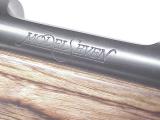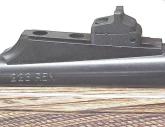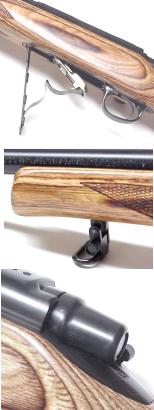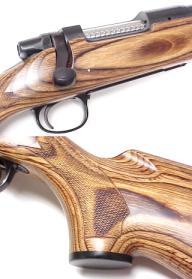
 I’ve never been much of a Model Seven fan. The barrel is too short, the stock is too stubby and it never seems properly scaled to the short cartridges it is designed to shoot. The action is short, but the barrel at the receiver looks .458 Winchester Magnum ready.
I’ve never been much of a Model Seven fan. The barrel is too short, the stock is too stubby and it never seems properly scaled to the short cartridges it is designed to shoot. The action is short, but the barrel at the receiver looks .458 Winchester Magnum ready.
The first time the need arose for a light gun, I passed on the Seven and went for a Winchester Model 70 Compact. The next time the choice was a Weatherby Ultralight then, finally, a Remington M700 Mountain rifle. In fact, it was while I was filling out the paperwork on the Mountain Rifle I noticed the new generation Model Seven. Not only did it have the deficiencies I noted earlier, it also had a laminated stock. I always thought these block of plywood looked garish, and were being pushed by manufacturers to save a couple of bucks or militant environmentalists who wished to save trees and be at one with their chipmunk. I hefted the gun, pointed it toward the mounted deer head hanging on the wall and cycled the action a couple of times. The Seven was really very nice, unfortunately this example was stainless – too bright and no sights.
That night my wife and I began discussing the fact our kids were grown and starting their own families. Regarding firearms, we thought it might be a good time to plan ahead. By the time these little guys are old enough to shoot, we’ll be living in rural Maine, and a nice small centerfire rifle would make a lot of sense. We thought we wanted a .223 that would be in a package small enough for use in teaching youngsters firearms skills, but also enjoyable for adults, and serve some purpose as a varmint popper around the house. The only think we liked in a small rifle was the Remington Model Seven.
 I bought a Model Seven LS (laminated stock). This particular model came with metallic sights and a blued finish. As you can see, the receiver ring is quite large, leading to a very much oversized barrel junction, followed by what could only be termed a dramatic taper, or heavy taper, or really big… The point is, the difference in diameter between the receiver and
I bought a Model Seven LS (laminated stock). This particular model came with metallic sights and a blued finish. As you can see, the receiver ring is quite large, leading to a very much oversized barrel junction, followed by what could only be termed a dramatic taper, or heavy taper, or really big… The point is, the difference in diameter between the receiver and  the pencil thin muzzle, forces the need for an extraordinarily high ramped front sight. This looks a lot better than it sounds, but the very high rear sight seems to balance it all out. The rifle is very balanced and steady to point. The rear sight is a casting, a giant, rough casting, rough finished glob of metal, perched on the very streamlined lightweight barrel. I believe the range of elevation adjustment is 2 or 3 thousand MOA, which allows the owner of this bee stinging .223 to be dead on at 1,500 yards. Alright!
the pencil thin muzzle, forces the need for an extraordinarily high ramped front sight. This looks a lot better than it sounds, but the very high rear sight seems to balance it all out. The rifle is very balanced and steady to point. The rear sight is a casting, a giant, rough casting, rough finished glob of metal, perched on the very streamlined lightweight barrel. I believe the range of elevation adjustment is 2 or 3 thousand MOA, which allows the owner of this bee stinging .223 to be dead on at 1,500 yards. Alright!
 Now that I’ve grown to like the idea of a detachable magazine after exposure to the Mountain Rifle DM, the Seven of course has a hinged floor plate and a magazine well that is home to 5 .223 cartridges. So much for me being able to switch quickly, between elephant dropping solids and varmint nailing hollow points. The lower gear is investment casting, which means I’ll spend a lot of time looking for a billet steel replacement. The trigger is a wonderfully sandpaper smooth 4 lbs – a future project.
Now that I’ve grown to like the idea of a detachable magazine after exposure to the Mountain Rifle DM, the Seven of course has a hinged floor plate and a magazine well that is home to 5 .223 cartridges. So much for me being able to switch quickly, between elephant dropping solids and varmint nailing hollow points. The lower gear is investment casting, which means I’ll spend a lot of time looking for a billet steel replacement. The trigger is a wonderfully sandpaper smooth 4 lbs – a future project.
The laminated stock aesthetic design is nice. It’s proportional, dimensioned correctly to point naturally on target, with real checkering laid out in appropriate panels. The metal finish is satin, as is the stock, and Remington was thoughtful in tossing in a set of sling swivels. Compared to last years walnut stock, this is a much more attractive package. Unfortunately, it’s tough to locate a decent sling that has such small spacing between swivels. I think the initial Cobra sling I tried weighed more than the gun. I have a different type of sling I’ll get around to installing that is similar to the shooting sling I installed on the Weatherby Ultralight.
The bolt shroud is conspicuously missing something, the new Remington bolt lock slot. I’m not sure if this feature hasn’t been implemented on this model, or this particular unit just isn’t equipped with one. The second notable point is the tight spacing of the two scope base holes. The new Model Sevens take a different rear base than earlier models.
 This is sort of interesting, a decent recoil pad on a rifle that generates about 3 lb of recoil from a 6.5 lb gun. It does make for a good no-slip surface. The little .223 has 300 yard reach and is generating as much power as a .45 ACP generates at the muzzle. I developed a respect for these little cartridges when a 1/2″ thick mild steel angled backstop that routinely deflected .45 ACP rounds, was penetrated with a .single .223 Remington 50 grain bullet exiting a 10″ Contender barrel.
This is sort of interesting, a decent recoil pad on a rifle that generates about 3 lb of recoil from a 6.5 lb gun. It does make for a good no-slip surface. The little .223 has 300 yard reach and is generating as much power as a .45 ACP generates at the muzzle. I developed a respect for these little cartridges when a 1/2″ thick mild steel angled backstop that routinely deflected .45 ACP rounds, was penetrated with a .single .223 Remington 50 grain bullet exiting a 10″ Contender barrel.
 I wanted to conclude by saying Remington did an outstanding job putting this little gun together. It is nicely done and feels like a piece of machinery. As a result of the gun’s use of an inexpensive cartridge, I have tons of brass, bullets, powder, primers and a lot of bench time set aside to play with.
I wanted to conclude by saying Remington did an outstanding job putting this little gun together. It is nicely done and feels like a piece of machinery. As a result of the gun’s use of an inexpensive cartridge, I have tons of brass, bullets, powder, primers and a lot of bench time set aside to play with.
Not only will this make a good shooting skills training rifle and a fun recreational gun, it is probably a good trainer for anyone picking up one of these gems in a heavier caliber like the: .260 Remington, 7mm-08, or even the .350 Remington Magnum.
During the next few weeks I hope to concentrate on the smaller bore centerfire cartridges, .224″ through .257″ particularly in areas of bullet construction assessment, accuracy and short barrel gun handload performance. Maybe I’ll come up with some loads that will perform just as good in the T/C. Maybe I’d find a scope. Maybe I’ll….
More “The Remington Model Seven”:
The Remington Model Seven…a great place to start
The Seven Project Part I Quick Detach Mount System
The Seven Project Part II Handload Development
‘The Seven Project Part III – even more development
The Seven Project Part IV
Handload Data – 223 Remington
Thanks,
Joe

Email Notification